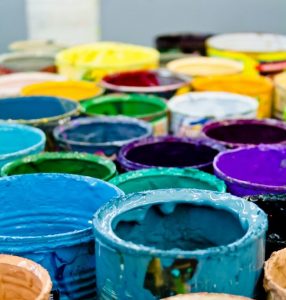Owning your own home means you can decorate the interior however you want. Maybe you are a first-time buyer ready to get stuck into some DIY painting. Maybe you want to spruce up your home. Prepare yourself with this complete checklist to help you paint your house like a pro.
Research and Planning
Like most of us, you will be taking inspiration from online magazines and places you may have visited. An excellent place to start is determining what will suit the room and what styles you like. You may want an accent wall to act as a feature with vibrant colours. Consider a contrasting colour on any mouldings. Don’t forget to check if the ceiling also needs some TLC. You can order testers online from Woodies to begin the search there.

Choose your Perfect Colour
Choosing your perfect colour can be both stressful and fun. Begin by considering what colours you would like in your space. For example, a small room may not be suited to a dark palette but would benefit from a range of neutrals if you have existing furniture be mindful of what works with those unless you are open to upgrading some furniture too. Visit dulux.ie and use their excellent paint generator to visualize how your room would look with a specific colour.
Pick your tools and Materials
Everyone will need the basics to start off when decorating their home. For the most part, these products can be used again, so see them as an investment once you look after them and follow the cleaning guidelines. You will need:
- Paint Brushes
- Roller Brush
- Roller Poll
- Paint Tray
- Painting Tape
- Sandpaper
- Putty Knife
- Old sheets/Drop Clothes
- Methylated Spirits
- Sugar Soap
How much paint you will need
A good gauge by experts is to account for one gallon per 400 square feet. If painting a large space, you might want to account for more and factor in how many coats you plan to do. Some colours will require more coats than others. For example, a dark room painted a lighted colour will need extra coats and an undercoat/primer. If you use rollers, allow for some initial soakage into the roller. If you want a more textured finish, you will use more paint than a smother glossier finish.
Prepare your walls
This is a crucial step before you begin painting any walls. If you are dealing with an older or well-lived house, you can revive walls by cleaning them with sugar soap to remove any dirt. If there are any holes or blemishes from blue tack or Sellotape, use a wall filler and sand it down until it is smooth. Next, you should use painter tape to protect any edges of windows, light fittings, corners or mouldings. Don’t forget to remove the furniture from the room if possible. If you can’t manage this, place all the items in the middle of the room and use drop clothes or old sheets to protect your items.
Pick your painting technique.
Know how you will tackle painting the room and stick with it. Take one wall at a time. Use a paintbrush around the edges and a roller to paint the remaining wall. Start at the top of the wall and work your way down to the floor. Make sure to do enough coats to cover the wall and use an undercoat where needed. If you plan on a feature wall with a different colour, do this last. Wait for the paint to dry. You can use painter’s tape to ensure your paint doesn’t bleed onto your newly painted wall.
Ventilation
You will want good ventilation when painting to allow paint drying and remove harsh paint smells. Opening windows and/or using fans will be perfect for this situation. Remember that you don’t want the room to be freezing, which will affect some paint drying time. If the weather is damp, this will also affect the drying time. Ideally, the summer months in Ireland are best for painting indoors and outdoors.
Prepare your paint
Mix your paint well before use with a wooden paint stick and stir occasionally throughout. Use your paint tray to dispense the paint using a roller. If you have multiple tins of paint, you can mix them together to ensure 100% that the colour is the same throughout your room. It’s essential to know the drying time for your paint so you know how long to leave it dry between coats. Check the tin for specifications.

Clean Up
Time to clean up. You’re nearly done. Carefully remove any painting tape from the walls, ceiling and skirting boards. Roll up drop clothes once they are dry of any paint spillages. Clean all your brushes, paint tray and rollers for when you want to use them again. Oil-based paints should be cleaned using methylated spirits. Water-based paints can be cleaned using soap and water. Make sure any leftover paint is sealed correctly and stored in a safe place. We have all seen the disasters that can happen when children use paint.
Time and Decoration
Now that you have a freshly painted home letting the paint dry properly is essential. You don’t want any unwanted marks on your walls from boxes or furniture pushing up against the walls. Again, when you are finished painting, make sure you leave the room well-ventilated to get rid of any lingering paint smells. Ideally, you should leave a room 24 hours before moving furniture or adding pictures to the walls. But check your paint for the brand specifications. Add your finishing touches at your leisure and enjoy your hard work. It’s amazing what a bit of paint can do to revive a room.
Health and Safety Precautions
Protective Gear
Your safety should be your top priority whenever you start a painting project. Although painting may seem harmless, it has several risks. Here is a list of the most essential protective gear:
- Masks: When sanding walls or working in a room with limited ventilation, wearing a mask is crucial. It prevents the inhalation of dust particles and potentially harmful paint fumes. For paints with high VOCs (Volatile Organic Compounds), consider using a respirator mask that offers a higher protection level.
- Gloves: Paint can contain chemicals that might irritate the skin or cause allergic reactions in some individuals. Wearing gloves, preferably nitrile or latex, can protect your hands from direct contact with paint and other solvents. They also offer a better grip on brushes and rollers, ensuring precision in your work.
- Safety Goggles: These are essential when sanding walls to prevent dust particles from entering your eyes. They also protect against paint splashes, especially when working overhead or using a roller.
- Coveralls or Old Clothing: While not harmful, getting paint on your favourite outfit can be frustrating. Wearing old clothes or a painter’s coverall can save you from potential stains.
Remember, while the goal is to achieve a beautifully painted space, your health and safety should never be compromised.
Safe Storage
You’ll probably have extra paint and supplies after finishing your painting project. Safety is a major consideration in proper storage, in addition to organisation. Here’s how to safely store your paint supplies:
- Elevated Shelves: Store paints and solvents on high shelves or in locked cabinets, ensuring children and pets are out of reach. Curious hands or paws can lead to spills, ingestion, or other accidents.
- Cool and Dry Place: Paints and solvents are best stored in a cool, dry place. Extreme temperatures, especially heat, can degrade the quality of the paint or even pose a fire risk with certain solvents.
- Tightly Sealed: Ensure that paint cans are sealed tightly. This prevents the paint from drying out and ensures it remains usable for future touch-ups or projects. Using a rubber mallet to close the lid can ensure a tight seal without deforming the can.
- Vertical Storage: Brushes should be cleaned, dried, and stored vertically, with the bristles facing upwards. This maintains their shape and prolongs their lifespan.
- Dispose Responsibly: If you have paint or solvents that you no longer need, don’t simply throw them in the bin. Many areas have specific disposal procedures or collection points for hazardous waste. Check with your local council or waste disposal facility for guidance.
You can ensure the durability of your materials and the security of your household by adhering to these storage recommendations.
Good luck with your new home or home decoration journey. Don’t forget to always insure your home with a good policy. KennCo provides a range of home insurance products to suit your needs. We offer Owner Occupied Home Insurance, Contents Only Home Insurance and Landlord Home Insurance.
Get a quote online for a competitive home insurance quote, or call us on 014092600. Here’s an article about two of KennCo’s home insurance benefits you may not know about.
